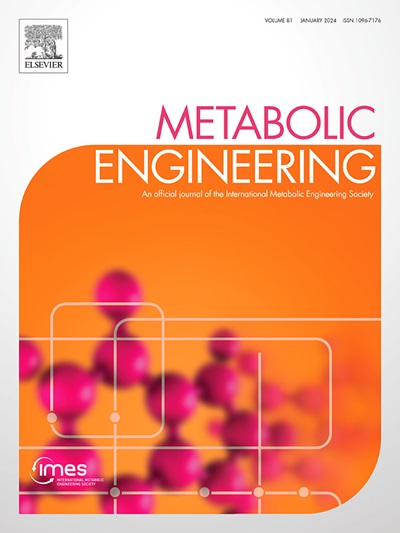用酶热优化改进代谢工程设计。
IF 6.8
1区 生物学
Q1 BIOTECHNOLOGY & APPLIED MICROBIOLOGY
引用次数: 0
摘要
代谢目标和策略设计在促进代谢工程中DBTL(设计-构建-测试-学习)循环中起着至关重要的作用。经典的化学计量算法(如OptForceMust和FSEOF)缩小了实验搜索空间,但未能考虑热力学可行性和酶的使用成本,从而为其预测性能留下了空间。在这项研究中,我们引入了ET-OptME,这是一个整合了两种算法的框架,系统地将酶效率和热力学可行性约束纳入基因组尺度代谢模型。与实验记录相比,ET-OptME通过逐步约束分层方法缓解热力学瓶颈并优化酶的使用,提供了更符合生理现实的干预策略。对谷氨酰胺棒状杆菌模型中5个产物靶点的定量评价表明,与化学计量法、热力学约束法和酶约束法相比,该算法的最小精度分别提高了292%、161%和70%,精度提高了106%、97%和47%。本文章由计算机程序翻译,如有差异,请以英文原文为准。
Improving metabolic engineering design with enzyme-thermo optimization
Metabolic target and strategy design play a critical role in enhancing the DBTL (Design-Build-Test-Learn) cycle in metabolic engineering. Classical stoichiometric algorithms such as OptForceMust and FSEOF narrow the experimental search space but fail to account for thermodynamic feasibility and enzyme-usage costs, leaving a space for their predictive performance. In this study, we introduce ET-OptME, a framework integrating two algorithms that systematically incorporate enzyme efficiency and thermodynamic feasibility constraints into genome-scale metabolic models. By mitigating thermodynamic bottlenecks and optimizing enzyme usage through a stepwise constraint-layering approach, ET-OptME delivers more physiologically realistic intervention strategies when compared with experimental records. Quantitative evaluation of five product targets in the Corynebacterium glutamicum model reveals that the algorithm showing at least 292 %, 161 % and 70 % increase in minimal precision and at least 106 %, 97 % and 47 % increase in accuracy when compared with stoichiometric methods, thermodynamic constrained methods, and enzyme constrained algorithms respectively.
求助全文
通过发布文献求助,成功后即可免费获取论文全文。
去求助
来源期刊

Metabolic engineering
工程技术-生物工程与应用微生物
CiteScore
15.60
自引率
6.00%
发文量
140
审稿时长
44 days
期刊介绍:
Metabolic Engineering (MBE) is a journal that focuses on publishing original research papers on the directed modulation of metabolic pathways for metabolite overproduction or the enhancement of cellular properties. It welcomes papers that describe the engineering of native pathways and the synthesis of heterologous pathways to convert microorganisms into microbial cell factories. The journal covers experimental, computational, and modeling approaches for understanding metabolic pathways and manipulating them through genetic, media, or environmental means. Effective exploration of metabolic pathways necessitates the use of molecular biology and biochemistry methods, as well as engineering techniques for modeling and data analysis. MBE serves as a platform for interdisciplinary research in fields such as biochemistry, molecular biology, applied microbiology, cellular physiology, cellular nutrition in health and disease, and biochemical engineering. The journal publishes various types of papers, including original research papers and review papers. It is indexed and abstracted in databases such as Scopus, Embase, EMBiology, Current Contents - Life Sciences and Clinical Medicine, Science Citation Index, PubMed/Medline, CAS and Biotechnology Citation Index.
 求助内容:
求助内容: 应助结果提醒方式:
应助结果提醒方式:


